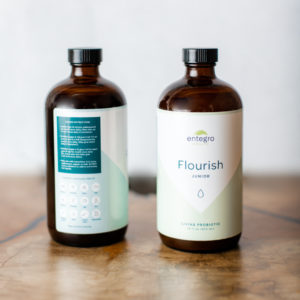PRO-101: A Brief History of Fermentation & Probiotics
The use of beneficial bacteria have been a major part of cultures since the beginning of time. Ancient cultures have used the mysterious process of fermentation for food preservation and for medicinal purposes.
Fermentation has been used for millennia to preserve food and beverages from spoiling.
Not only was fermentation used as a form of preservation, but a healthy addition of bacteria for the consumer (host). Derived from the Greek words “for life”, probiotics are now defined by the International Scientific Association for Probiotics and Prebiotics (ISAPP) as “Live microorganisms that, when administered in adequate amounts, confer a health benefit on the host.”1
Fermentation is the metabolic process by which bacteria and yeast convert a carbohydrate, such as starches in veggies or sugar in milk and sweet teas, into an acid or alcohol.
As the bacteria use the carbohydrates to grow, they produce metabolic byproducts, AKA metabolites. These metabolites lower the pH and prevent spoilage. Made up of organic acids, peptides, bacteriocins, and short-chain fatty acids, metabolites also provide many benefits to the host.2,3
Cultures from around the world have used this method to preserve and flavor foods and drinks for centuries.
Some of the earliest evidence of fermentation are found in Egypt and the Middle East as long ago as 7000 BC!2 All sorts of foods have been and continue to be fermented, including dairy in the form of
-
- Cheeses
- Kefir
- Kumiss/zabadi/doogh/dahi
- Bread
- Chocolate
- Soy
- Sausages
- Vegetables
- Beer
- Wine
In some cultures, the process of leavening of bread or bubbling of wine was attributed to divine intervention – an unknown being, intervening to the benefit of humankind.
In the 1680s, Dutch scientist Antonie van Leeuwenhoek invented the microscope.
Equipped with this fancy new tool, Antoine used his microscope to view any and all things. One of the first bacteria he observed was found in the plaque from his teeth. He was also the first to observe yeast cells fermenting. Shrouded in mystery, the observations of van Leeuwenhoek were largely forgotten after his death because he kept his microscope-making process very private.
Fast forward to the late 1700s, Frenchman Antoine Lavoisier looked at fermentation from a chemist’s perspective.
Considered the father of modern chemistry, Antione Lavoisier, described the fermentation chemical process by which sugars are turned into alcohol and carbon dioxide. This unlocked a key piece of the fermentation puzzle.
In the mid-late 1800s, French chemist Louis Pasteur concluded that lactic acid fermentation was created through microorganisms.
Because Pasteur was also a biologist and microbiologist, he looked at bacteria not in isolation, but as part of the bigger picture. He described the process as, “respiration without air,” showing the continued mystery of bacteria and yeast at work.2, 4
The process of pasteurization came from Louis. He discovered that when food and beverages are heated to a temperature of 60 – 100 degrees, the bacteria or mold already present is killed. He patented the process, which became widespread in the 1860s.
Summary
Fermentation has been shrouded in mystery and the interest of scientists for hundreds of years. Each discovery furthered understanding to make the next discovery possible.
The connection between fermented foods and health has been around since fermentation has been used to preserve food.
Ancient healers recommended fermented foods and drinks as a medicine for all kinds of illnesses. In fact, Hippocrates declared more than 2000 years ago that “all disease begins in the gut” and “bad digestion is the root of all evil.”
But it was Russian scientist Elie Metchnikoff in 1907 who began to connect the dots in the modern science world.5
He observed the exceptionally long lives of Bulgarian rural population and associated the regular consumption of fermented milk products such as yogurt and kefir with the increased lifespan. Metchnikoff was the first to state, “the dependence of the intestinal microbes on the food makes it possible to adopt measures to modify the flora in our bodies and to replace the harmful microbes by useful microbes.”4 This is the first modern definition of probiotics and defined fermented milk as the first “functional food.” Catching up with Hippocrates, who was the first to say “Let food be thy medicine and medicine by thy food.”2,4
It seems as though “progress” has taken us away from our nomadic roots, which relied entirely on land as it was.
Varying seasons produced varying foods in abundance. This required natural means of preservation in order to have food for difficult times (ie winter in Iowa). As humans continued to settle and domestic, some of these benefits of diversity were lost. Even the art of cheese making was temporarily lost during the high middle ages, as domestication, settlement, and the government was developing.4 Thankfully those practices were recovered in the late middle ages by monks who produced the fermented dairy product. Monks are also widely known and thanked for their fermentation practices in the beer realm.
One of the first uses of probiotics as a supplement began in the early 1930s.
Japanese scientist Dr Minoru Shirota selected and cultivated the Lactobacillus casei bacteria. He developed a method of growth in milk and distributed the small bottles by ladies with the goal of improving the health of the people and prevent infectious disease.6
Most recently, a common practice for the delivery of probiotics is a four-step process:
- Grow the bacteria up in a liquid state
- Centrifuge the bacteria off away from the growth medium
- Freeze-dry the bacteria
- Encapsulate
Here at Entegro Health, we believe in keeping the bacteria in the most natural state – liquid. 
We keep the bacteria, growth medium, and all the advantageous metabolites together for a beneficial acidic environment. The eleven strains have carefully been selected to grow well together, a kind of diverse bacterial support group. We are proud to be a part of this ancient legacy of beneficial microbes as we join you in your journey to optimal health.
- Gouldin, B. R. (1998). Health benefits of probiotics. British Journal of Nutrition, 80(2), 203-207. Retrieved July 18, 2019, from https://www.cambridge.org/core/services/aop-cambridge-core/content/view/7160DC6D246DD86558F316AE581B9443/S0007114500006036a.pdf/health_benefits_of_probiotics.pdf. https://www.longdom.org/open-access/probiotics-history-and-evolution-2329-8731.1000107.pdf
- Fu, R. H., Wu, D. C., Yang, W., Scoffield, J., & Benveniste, E. N. (2017). Probiotic Metabolites Promote Anti-inflammatory Functions of Immune Cells [Abstract]. FASEB Journal. Retrieved July 29, 2019, from https://www.fasebj.org/doi/abs/10.1096/fasebj.31.1_supplement.1048.1
- Giovannia, G., MD, PhD, Fiorenza, B., MD, & Annaguilia, G., MD. (2016). Probiotics History. Clinical Gastroenterology,50, 116-119. Retrieved July 29, 2019, from https://journals.lww.com/jcge/Fulltext/2016/11001/Probiotics_History.3.aspx.
- Islam, S. U., MD, RPh. (2016). Clinical Uses of Probiotics. Medicine,95(5), 1-5. Retrieved July 29, 2019, from https://www.ncbi.nlm.nih.gov/pmc/articles/PMC4748908/pdf/medi-95-e2658.pdf.
- Contributing to the health and happiness of people around the world. (n.d.). Retrieved July 29, 2019, from https://www.yakult.co.jp/english/ RO


 New customers! Get 11% OFF your first Flourish order with Code FRESHSTART11
New customers! Get 11% OFF your first Flourish order with Code FRESHSTART11